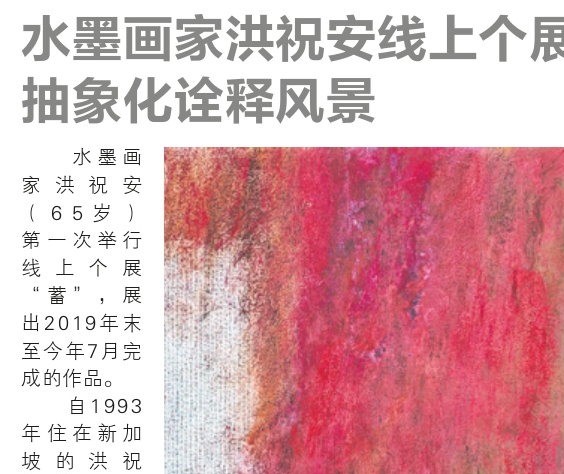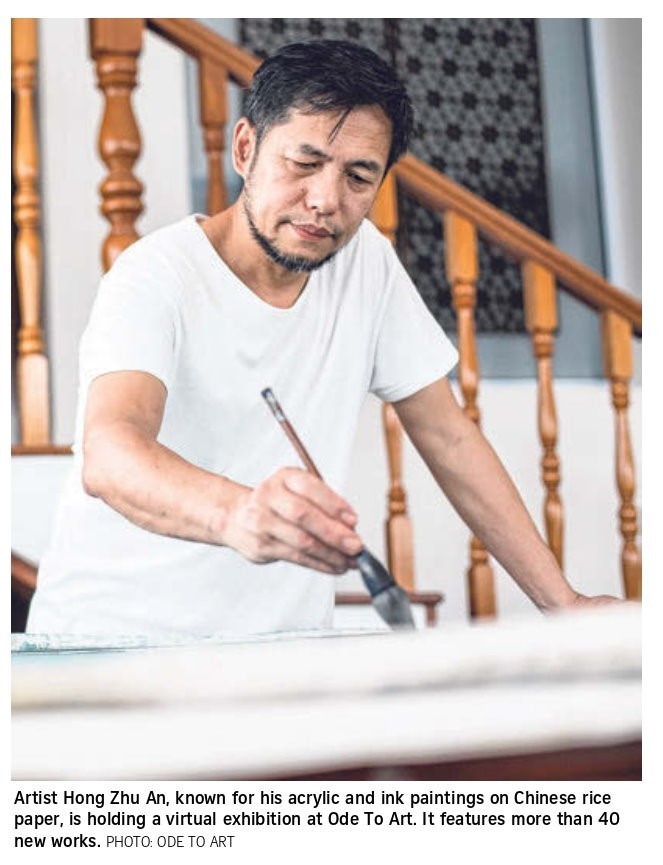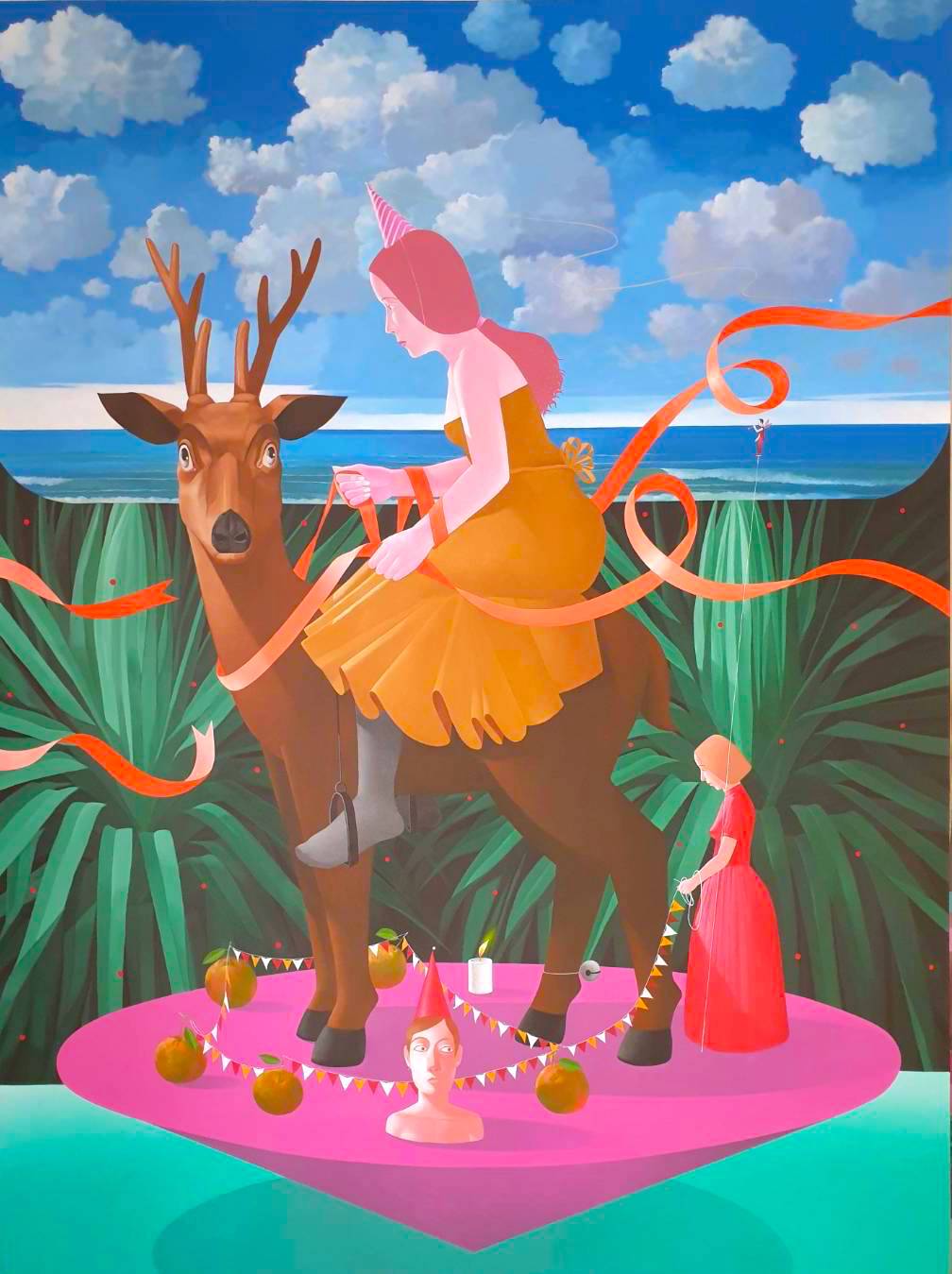
All About Artists
Into the Folds of Time: An Interview with Knakorn Kachacheewa
A look into the inspiration behind the Thai artist's newest series of works, as well as his journey pursuing his craft.
By Bridget
In anticipation of our upcoming Livestream with Thai artist Knakorn Kachacheewa, we managed to sit down with the artist in an eye-opening zoom dialogue. After Mr. Kachacheewa’s 2015 exhibition with us at Ode To Art, the artist will be bringing us a new series of works from his 2020 collection. Do join us for our upcoming Facebook Live with the artist on the 12th of November 2020 (8pm), to get a sneak peek into Mr. Kachacheewa’s studio and his newest paintings.
In his new series of work, Kachacheewa focuses on the concept of time - questioning our ideas of permanence, space, place, synchronically, and diachronically through time. Drawing inspiration from how "time parallels another that something continues", he uses his surreal narratives to spin a tale of humans, animals, objects, and places. Exploring the mimesis in modern life, the symbols in his work critique perceptions of class, marriage, and career in the human condition. Taking reference from modern society today, he bridges elements of metropolitan life and nature, as Kachacheewa's jovial scenes of fairgrounds and temples transform into safe spaces - hiding our need for faith and hope in these tumultuous times.
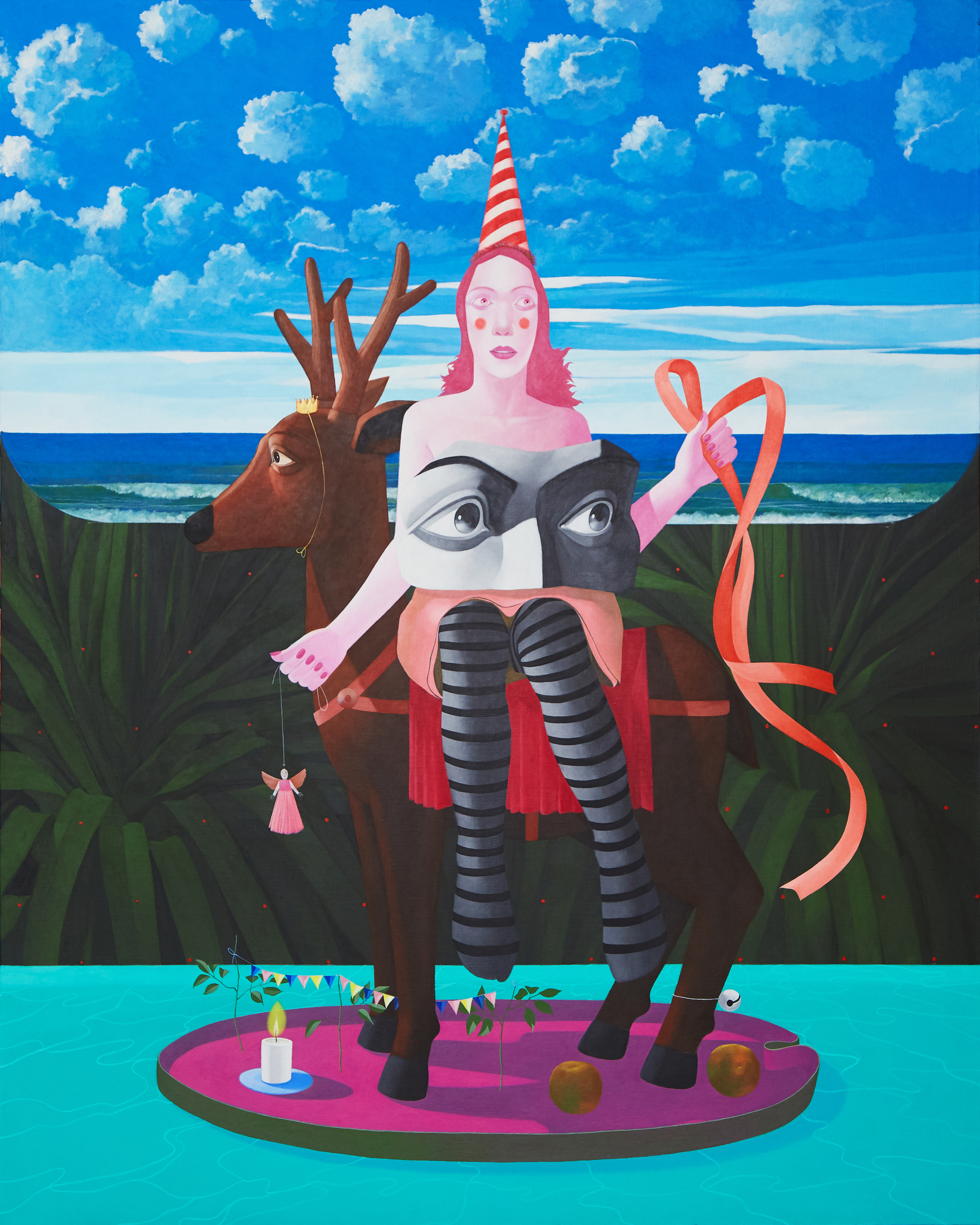
The Eyes That I Stole, 150 x 120 cm
How did you get started pursuing the arts?
When I was younger, I often drew comics inspired by comic book superheroes. My father noticed my hobby and let me attend art school, where I studied visual arts. From there, I practiced and honed my discipline and technical skills. The journey was difficult, as most Thai families do not support pursuing the arts as a full-time career, and view it as a hobby instead. My family wanted me to study something more conventional and lucrative such as marketing or business. [laughs]
Tell us more about your journey and how you became an artist. When did you realise you wanted to pursue it professionally?
My journey as an artist started when I took on the job of being a professor at a university. In Thailand, being a full-time professional artist is definitely not conventional and not sustainable, so I had to manage my career first. From there, I started creating some of my own works and slowly growing my collection of pieces. Economically, art is not a sustainable full-time career in Thailand, so there is a need to balance both of my occupations.
Did you paint before becoming a professor? Or did your artistic career only start after working at the university?
I first started working with printmaking, then 10 years ago I started painting and never looked back. Once I grew interested in painting as a medium, I realised how much I enjoyed it and worked with it all the time.

Ballet Girl (2019), Acrylic on Canvas, 150 x 120 cm
Many of our viewers are excited to see more of your works ever since your 2015 exhibition with us. Tell us more about your new collection and what your collectors can anticipate seeing this time.
The new collection is a continuation of my previous series in 2015. After receiving many requests from collectors to continue with this style, I decided to use lighter and softer colours to fit the theme of this new series, while maintaining the aesthetic that my collectors enjoyed.
What brought about this change? Was it due to feedback from your audiences?
It’s a 50-50 situation. On one hand, I do have my own ideas for this series, but I also received a number of suggestions asking after this collection and my new works. I wasn’t planning on deviating much from my style, so I took note of what my collectors enjoyed and improved it, incorporating it into my new series of works. In this new series, I am interested in the time that is associated with other periods, the time that cannot be specific. It can be divided into several segments that take place differently. Thus, imitation and story-telling are utilized. When we are confronting any situation, there is another space of another time occurring, telling a story which is harmonious, yet always conflicted.

Girl on Hart, 200 x 150 cm
How do you balance your work in university and your artistic practice?
I am currently working as an associate professor at the university, so I do get ample rest time during the holidays and after classes. In the summer, when I’m on a break after class, I take the opportunity to work on my art in the evenings. I try to keep a habit of spending 2-3 hours painting every day in my studio.
It takes a lot of dedication to take 2-3 hours a day to practice
I don’t view this time practicing as something tedious. After work, my time in the studio is a time of relaxation, and I take the time to focus on my painting and clear my mind while listening to music.
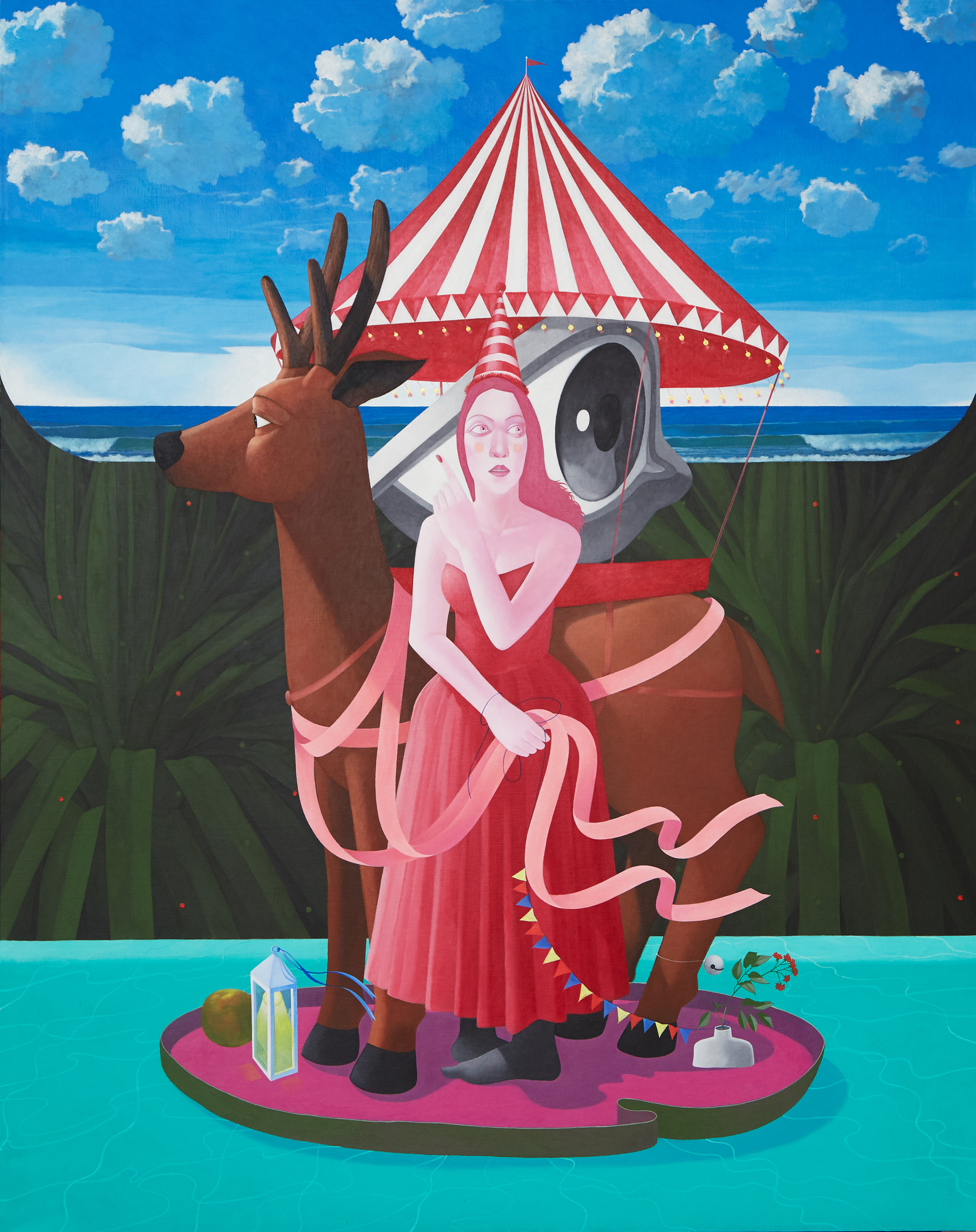
Your Eyes are Stolen, 150 x 120 cm
What is your process in the creation of a new artwork or a piece? From the first idea to the actual painting, how does it happen?
I usually piece together my main concept in the finishing stages of the painting, but I always start off with a collection of sketches and visuals I want to incorporate.
We know your paintings are full of symbols, could you share about the background behind some of the symbols that appear in your latest series?
For example, the ribbon is symbolic of beauty and liveliness, while also reflecting the conflicting notions of free will and authority. In Thailand, our female school uniforms are required to be accessories with hair ribbons. Responding to this authority in the education system, all girls in school have to tie this hair ribbon.

Ballet Girl with Herself, 150 x 120 cm
A question that I have about one of the characters that we see often, is the ballet girl, is it the same girl across the paintings? Or are each of them meant as a standalone piece?
The girls in the paintings are not the same girl, and each of them represents a symbolic woman: she is no one in particular, so she could be anyone. I want to portray the image of a regular girl, so that anyone may identify with her. The colours I use are meant to reflect the perceived happiness that we all strive to achieve. For example, one of the settings I paint is of a local Thai amusement park, while not as fanciful as its larger international counterparts, these small local parks are the only places most of the Thai community can afford to go to. Across the world, I believe everyone, like the figures in my work, has their own safe spaces of refuge from society. As such, these settings become small facets of happiness for them, being the locations that they can afford and feel comfort and hope in.
If you would like to find out more about Knakorn Kachacheewa's works, feel free to visit our artist profile here at Ode To Art. Additionally, come down to join us for our Livestream with the artist at 8pm, 12th November 2020, at Ode To Art's Facebook page.
Subscribe to our social media platforms for more exclusive insights into your favourite artists and artworks!
In his new series of work, Kachacheewa focuses on the concept of time - questioning our ideas of permanence, space, place, synchronically, and diachronically through time. Drawing inspiration from how "time parallels another that something continues", he uses his surreal narratives to spin a tale of humans, animals, objects, and places. Exploring the mimesis in modern life, the symbols in his work critique perceptions of class, marriage, and career in the human condition. Taking reference from modern society today, he bridges elements of metropolitan life and nature, as Kachacheewa's jovial scenes of fairgrounds and temples transform into safe spaces - hiding our need for faith and hope in these tumultuous times.

The Eyes That I Stole, 150 x 120 cm
How did you get started pursuing the arts?
When I was younger, I often drew comics inspired by comic book superheroes. My father noticed my hobby and let me attend art school, where I studied visual arts. From there, I practiced and honed my discipline and technical skills. The journey was difficult, as most Thai families do not support pursuing the arts as a full-time career, and view it as a hobby instead. My family wanted me to study something more conventional and lucrative such as marketing or business. [laughs]
Tell us more about your journey and how you became an artist. When did you realise you wanted to pursue it professionally?
My journey as an artist started when I took on the job of being a professor at a university. In Thailand, being a full-time professional artist is definitely not conventional and not sustainable, so I had to manage my career first. From there, I started creating some of my own works and slowly growing my collection of pieces. Economically, art is not a sustainable full-time career in Thailand, so there is a need to balance both of my occupations.
Did you paint before becoming a professor? Or did your artistic career only start after working at the university?
I first started working with printmaking, then 10 years ago I started painting and never looked back. Once I grew interested in painting as a medium, I realised how much I enjoyed it and worked with it all the time.

Ballet Girl (2019), Acrylic on Canvas, 150 x 120 cm
Many of our viewers are excited to see more of your works ever since your 2015 exhibition with us. Tell us more about your new collection and what your collectors can anticipate seeing this time.
The new collection is a continuation of my previous series in 2015. After receiving many requests from collectors to continue with this style, I decided to use lighter and softer colours to fit the theme of this new series, while maintaining the aesthetic that my collectors enjoyed.
What brought about this change? Was it due to feedback from your audiences?
It’s a 50-50 situation. On one hand, I do have my own ideas for this series, but I also received a number of suggestions asking after this collection and my new works. I wasn’t planning on deviating much from my style, so I took note of what my collectors enjoyed and improved it, incorporating it into my new series of works. In this new series, I am interested in the time that is associated with other periods, the time that cannot be specific. It can be divided into several segments that take place differently. Thus, imitation and story-telling are utilized. When we are confronting any situation, there is another space of another time occurring, telling a story which is harmonious, yet always conflicted.

Girl on Hart, 200 x 150 cm
How do you balance your work in university and your artistic practice?
I am currently working as an associate professor at the university, so I do get ample rest time during the holidays and after classes. In the summer, when I’m on a break after class, I take the opportunity to work on my art in the evenings. I try to keep a habit of spending 2-3 hours painting every day in my studio.
It takes a lot of dedication to take 2-3 hours a day to practice
I don’t view this time practicing as something tedious. After work, my time in the studio is a time of relaxation, and I take the time to focus on my painting and clear my mind while listening to music.

Your Eyes are Stolen, 150 x 120 cm
What is your process in the creation of a new artwork or a piece? From the first idea to the actual painting, how does it happen?
I usually piece together my main concept in the finishing stages of the painting, but I always start off with a collection of sketches and visuals I want to incorporate.
We know your paintings are full of symbols, could you share about the background behind some of the symbols that appear in your latest series?
For example, the ribbon is symbolic of beauty and liveliness, while also reflecting the conflicting notions of free will and authority. In Thailand, our female school uniforms are required to be accessories with hair ribbons. Responding to this authority in the education system, all girls in school have to tie this hair ribbon.

Ballet Girl with Herself, 150 x 120 cm
A question that I have about one of the characters that we see often, is the ballet girl, is it the same girl across the paintings? Or are each of them meant as a standalone piece?
The girls in the paintings are not the same girl, and each of them represents a symbolic woman: she is no one in particular, so she could be anyone. I want to portray the image of a regular girl, so that anyone may identify with her. The colours I use are meant to reflect the perceived happiness that we all strive to achieve. For example, one of the settings I paint is of a local Thai amusement park, while not as fanciful as its larger international counterparts, these small local parks are the only places most of the Thai community can afford to go to. Across the world, I believe everyone, like the figures in my work, has their own safe spaces of refuge from society. As such, these settings become small facets of happiness for them, being the locations that they can afford and feel comfort and hope in.
If you would like to find out more about Knakorn Kachacheewa's works, feel free to visit our artist profile here at Ode To Art. Additionally, come down to join us for our Livestream with the artist at 8pm, 12th November 2020, at Ode To Art's Facebook page.
Subscribe to our social media platforms for more exclusive insights into your favourite artists and artworks!


